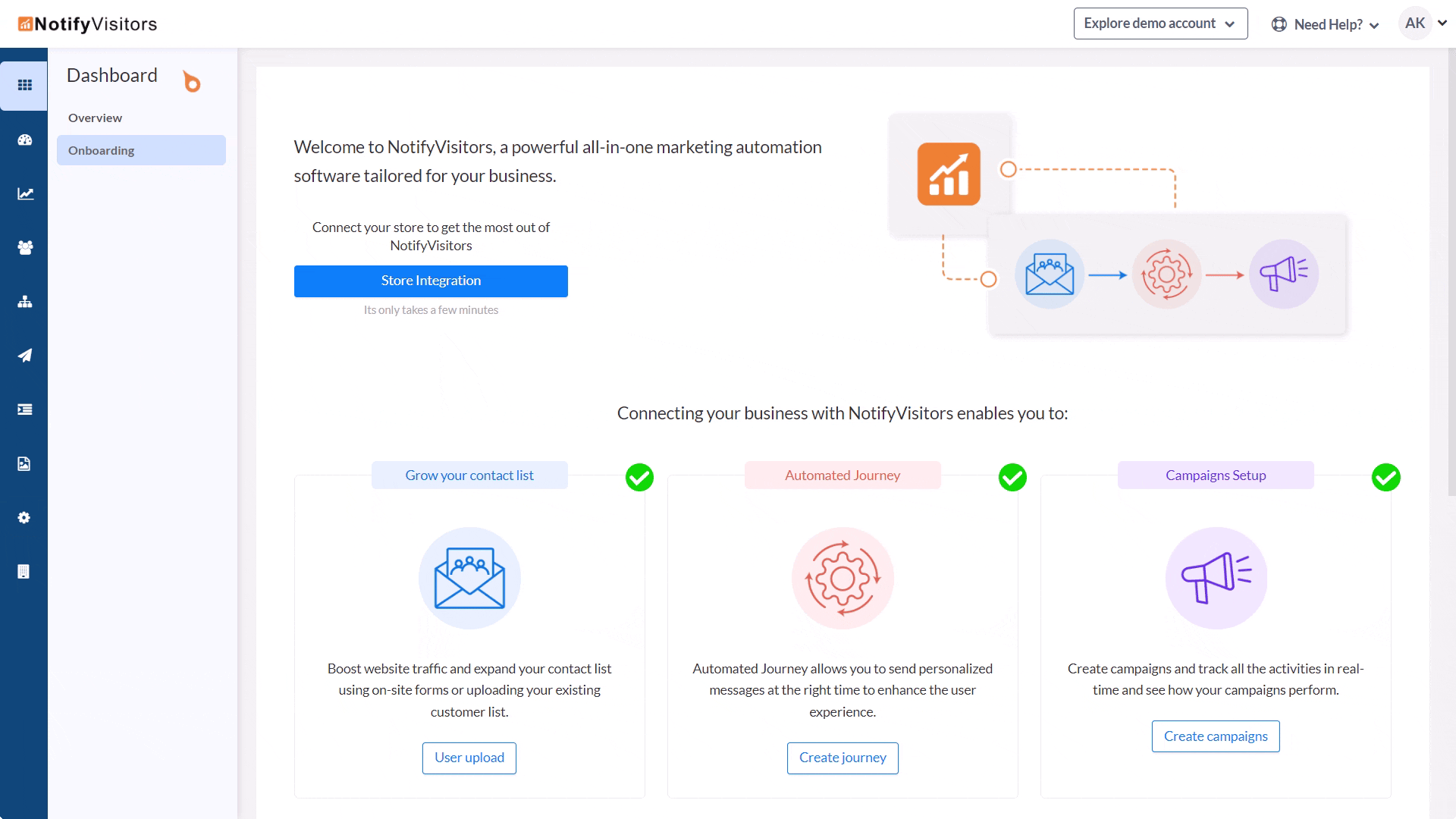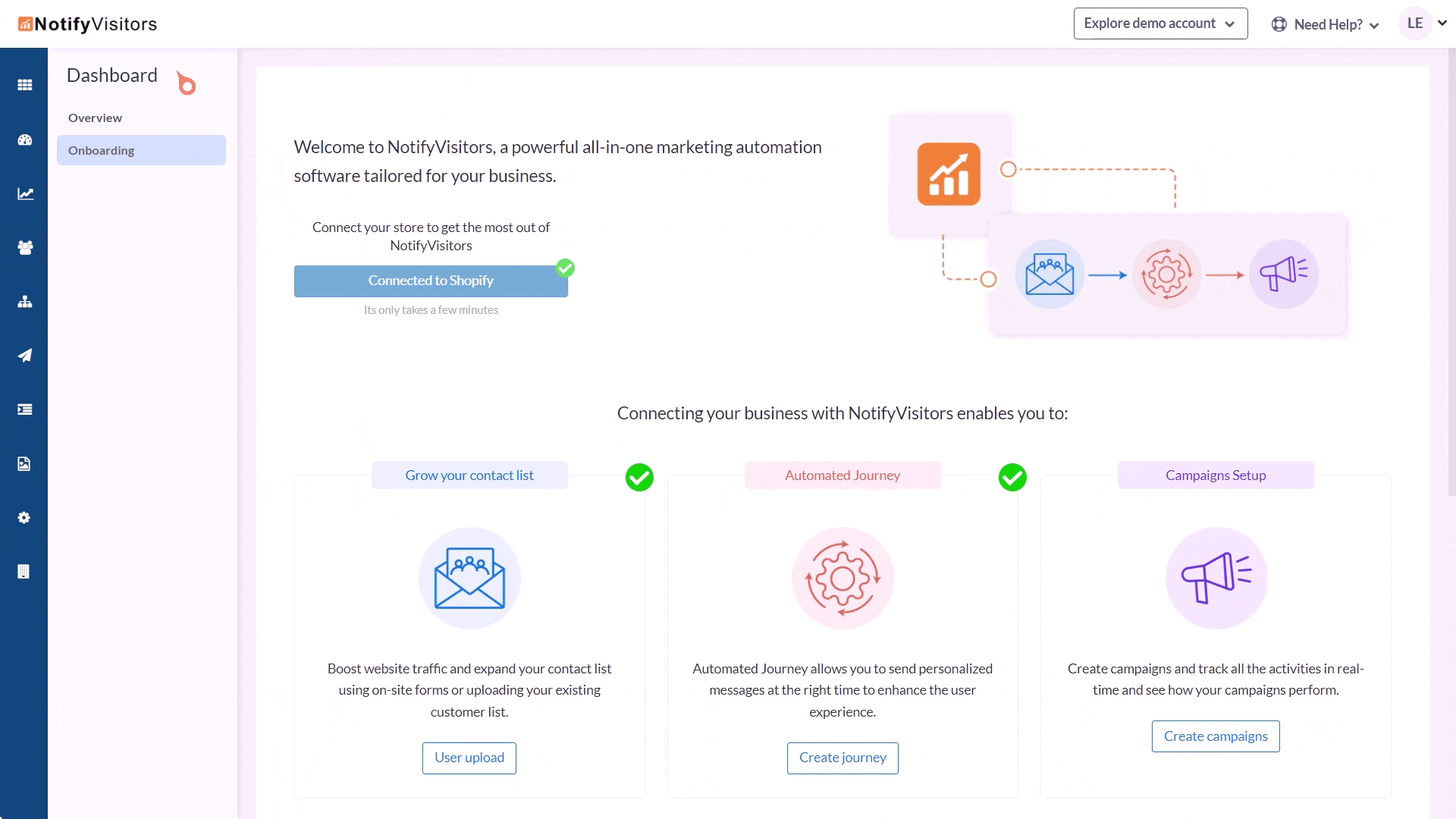'Google Analytics', or GA, is a web analytics service offered by 'Google LLC', that provides organizations with a comprehensive assessment of their website and app performance. Meaning, it is an analytics tool that tracks and reports website traffic, mobile app traffic and events, currently as a program within the Google Marketing Platform.
It is used to track activity such as session duration, pages per session, bounce rate of individuals using a website along with the information on the source of the traffic. It seamlessly integrates with Google's marketing/advertising platforms and products such as Google Ads, Search Console, Data Studio etc. making it a convenient choice for anyone using multiple Google tools.
GA’s approach is to render high-level, dashboard-type data for the casual user, and more in-depth data further into the report set. In order to enhance our user analytics services, we devised a novel feature that enables you to effortlessly integrate your NotifyVisitors account with Google Analytics by means of a toggle switch. In this article, you’ll learn how to activate and use this new feature of our software.
In essence, the aforementioned switch, once turned on, associates the NotifyVisitors user IDs (saved in your account’s database) with the corresponding GA IDs that Google generates whenever users arrive on or visit your organization’s online store/website. Please note that Google generates a unique GA ID for each user who visits your website, typically associated with the source of their visit.
How to enable GA ID tracking
This feature enables you to control tracking of GA IDs directly via the software’s dashboard so that you may, for the purpose of analysis, procure much more granular user data.
The primary purpose of this novel feature is to provide valuable insights into the referral sources of signups since Google can track information pertaining to the source of traffic to your online store/website.
Kindly follow the undermentioned step-by-step procedure to enable tracking of Google Analytics IDs.
- Navigate to Dashboard > Settings > Users.
- Right under the subsection titled 'Collect Subscribers', you’ll notice that there exists an 'Attributes Table' listing the details of various attributes (both system and custom). Next, you'll observe that within that table, the very first attribute is the one titled 'GA_Client_ID'.
- To enable tracking of GA IDs upon signup form submissions, you’ll have to activate this specific attribute. You will notice that for this specific attribute, under the column titled 'Status', there exists an 'Activate' button. Simply, click on that button in order to activate the attribute.

Note
Once you click on the 'Activate' button, it will automatically disappear from the interface and will be replaced by an 'Active' status indicator meant to convey that the attribute is now in its operational state.
In other words, the 'Active' status indicator communicates that the software is now actively linking the NotifyVisitors user IDs with their corresponding GA IDs upon signup form submissions. Additionally, under the attribute’s 'Created On' column, a 'timestamp' mentioning the 'date' and 'time' when the attribute got activated will appear.

How GA IDs get tracked in NotifyVisitors
- The software registers all visitors to your online store within your NotifyVisitors account's database (which is maintained at the server), by means of creating a distinct ID for each visitor. This specific ID is called the NotifyVisitors user ID or 'NVUID'.
- When users visit your brand's online store via Google Search, any web page, website, app, or by means of clicking on an online advertisement, then Google too generates a unique GA ID for each user typically associated with the source of his/her visit.
It is for this reason that GA IDs can furnish valuable insights into the referral sources of signups.
- If the 'GA_Client_ID' attribute has been activated in the panel as per the procedure described above, then the software will not just track visitors to your store but will also track the unique GA ID of each visitor and associate the same with the respective NotifyVisitors user ID.
- Whether, for any specific user, the GA ID is getting successfully retrieved and mapped against his/her NotifyVisitors user ID, can be confirmed or verified from the panel’s 'User List' section. To do so, simply:
- Navigate to Dashboard > Segments > User List.
- Enter a previously known identification detail such as NVUID, name, email ID etc. of the user, in the 'Search' bar so as to filter him/her out.
- Next, click on the User’s Name.
- Upon doing so, a new frame would appear on-screen containing detailed information about that specific user. Click on the 'Attributes' tab to ascertain whether the GA ID associated with the user got successfully recorded in your NotifyVisitors account’s database.

How to deactivate GA ID tracking
You can choose to deactivate GA ID tracking anytime. To do so, simply:
- Navigate to Dashboard > Settings > Users.
- Next, within the 'Attributes Table' table, locate the 'GA_Client_ID' attribute (which is usually the very first attribute listed in the table).
- You'll notice that for the attribute, under the column titled 'Options', there exists a circular button. Kindly click on that button and from within the dropdown that appears, select the option titled 'Deactivate' in order to disable further tracking of GA IDs.

Note
- GA IDs are unique for every user and web browser.
- GA IDs get tracked and stored by the software whenever a user submits a signup form irrespective of whether the form was created and deployed using NotifyVisitors or some other marketing automation software.
- For each user, the Google generated GA ID will be distinct across different browsers. Furthermore, the GA ID of a user will get updated in the software whenever he/she fills up a form i.e., the GA ID stored within your account’s database will correspond to the last form filled out by the user.
Was this article helpful?
That’s Great!
Thank you for your feedback
Sorry! We couldn't be helpful
Thank you for your feedback
Feedback sent
We appreciate your effort and will try to fix the article